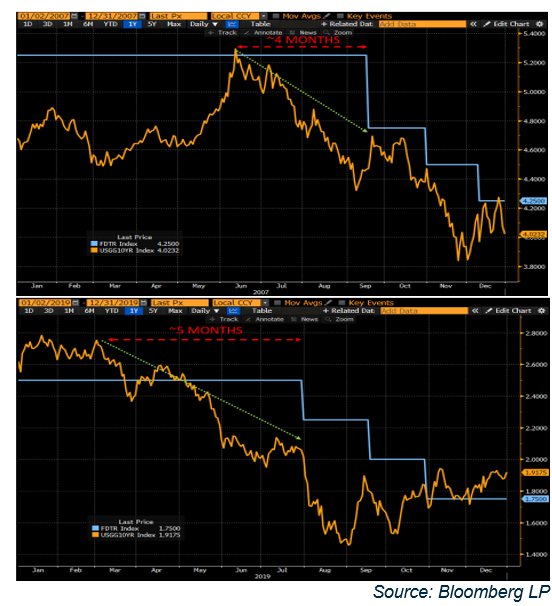Don’t wait for the Fed
Doug Drabik discusses fixed income market conditions and offers insight for bond investors.
The bond market has been very responsive to economic views concerning inflation. The Federal Reserve (Fed) has been very attentive to inflation as they continue to declare, with persistence, a policy geared to achieving a 2% core Personal Consumption Expenditure (PCE) level. If the Fed views inflation as being under control and progressing toward its goal, it will be incentivized to combat any economic activity slowdown by cutting interest rates. When the Fed cuts interest rates, they are lowering the Fed Funds rate. Fed Funds are reserves held in the Federal Reserve account – typically bank overnight funds. The Federal Reserve policy can set the tone that drives interest rates across the maturity range but an earlier market rate downturn can occur as a signal of investor perception of a slowdown in the economy. An aggressive move by the Fed likely shifts the entire range of yields, albeit not necessarily in parallel fashion.
The graphs depict the 10-year Treasury rate in relationship to the Fed Funds rate before and after the last two policy cuts in 2007 and 2019. History reflects that longer-term rates begin to fall before the actual Fed cut. In these two cases, interest rates started falling four and five months prior to the Fed’s move.
The message is simple but important. Most portfolios benefit from a balance of growth and wealth preservation assets, regardless of the interest rate environment. Individual bonds provide a means to preserve capital largely because of their unique characteristic of a stated maturity. Face values are returned to investors, barring a default and regardless of interim rate fluctuations during an investor’s holding period. With interest rates at levels not consistently seen in nearly 17 years, investors benefit from capital preservation and reap the value of elevated income associated with this rate environment.
Don’t wait for the Fed to change policy. If history repeats itself, postponing investing until the Fed cuts rates, misses a significant yield opportunity. Look to bolster income for the long term while keeping an appropriate portfolio balance now, while the window of opportunity allows.
The author of this material is a Trader in the Fixed Income Department of Raymond James & Associates (RJA), and is not an Analyst. Any opinions expressed may differ from opinions expressed by other departments of RJA, including our Equity Research Department, and are subject to change without notice. The data and information contained herein was obtained from sources considered to be reliable, but RJA does not guarantee its accuracy and/or completeness. Neither the information nor any opinions expressed constitute a solicitation for the purchase or sale of any security referred to herein. This material may include analysis of sectors, securities and/or derivatives that RJA may have positions, long or short, held proprietarily. RJA or its affiliates may execute transactions which may not be consistent with the report’s conclusions. RJA may also have performed investment banking services for the issuers of such securities. Investors should discuss the risks inherent in bonds with their Raymond James Financial Advisor. Risks include, but are not limited to, changes in interest rates, liquidity, credit quality, volatility, and duration. Past performance is no assurance of future results.
Investment products are: not deposits, not FDIC/NCUA insured, not insured by any government agency, not bank guaranteed, subject to risk and may lose value.
To learn more about the risks and rewards of investing in fixed income, access the Financial Industry Regulatory Authority’s website at finra.org/investors/learn-to-invest/types-investments/bonds and the Municipal Securities Rulemaking Board’s (MSRB) Electronic Municipal Market Access System (EMMA) at emma.msrb.org.



